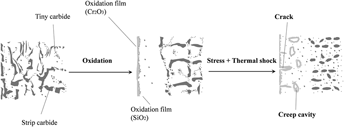Article contents
Investigations on servicing damage mechanisms of Cr35Ni45Nb alloy under complex conditions
Published online by Cambridge University Press: 10 May 2016
Abstract

The damage induced by oxidation and stress during the service process of Cr35Ni45Nb alloy and their influences on the microstructure evolution and creep rupture life of this alloy were studied. Continuity, compactness, and high temperature stability of the oxide layers are conductive to the performance of the alloy. A slight but complete layer of oxidation on surface improves the creep rupture life of the specimens. However, being exposed to long-term oxidation is observed to be counter-productive. Temperature stress generated during the air-cooling process creates large carbides near the surface of the specimen's cracks. Moreover, tiny carbides are precipitated from γ matrix and interfacial defects due to creep stress, but strip carbides are dissolved due to creep stress and the Gibbs–Thomson effect.
- Type
- Articles
- Information
- Copyright
- Copyright © Materials Research Society 2016
Footnotes
Contributing Editor: Jürgen Eckert
References
REFERENCES
- 6
- Cited by





